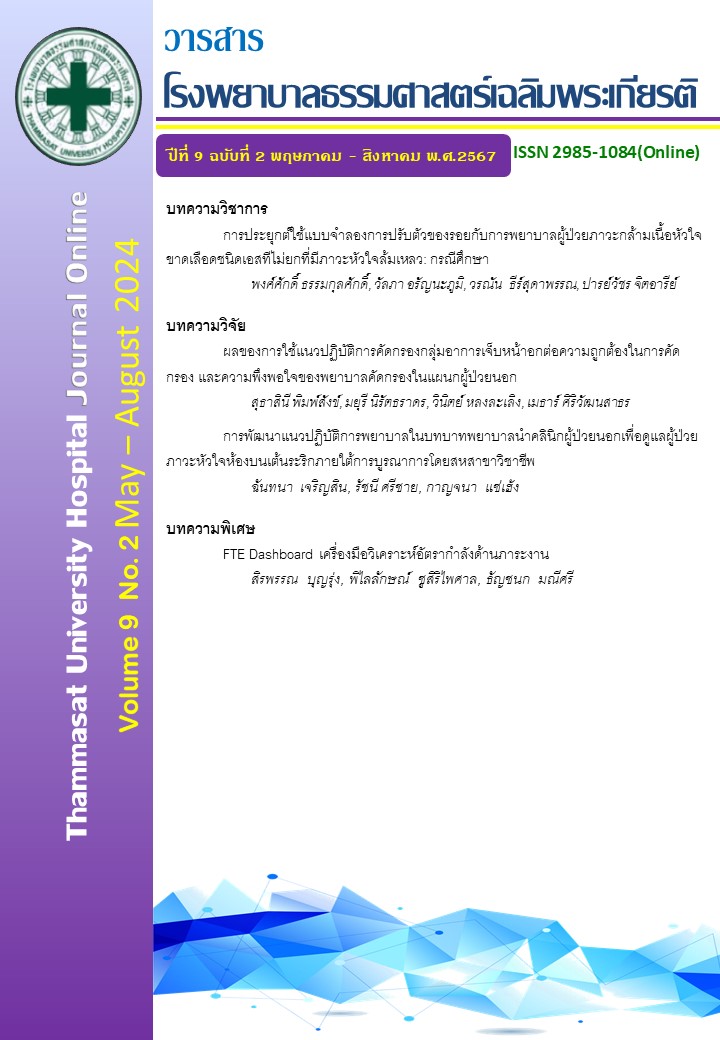Workload Analysis for Workforce Management through FTE Dashboard
Keywords:
Workforce analysis, Full-Time Equivalent, Patient and personnel safety, Employee engagementAbstract
Background: According to the situation of healthcare workforce shortages and the challenges of managing manpower, which is based on patient numbers, consider sufficiency not only in terms of staff numbers but also ensuring patient and personnel safety. Bangkok Phuket Hospital recognizes the importance of personnel care, which is the most valuable resource of the organization.
Objective: To develop the tools that assist decision-making by utilizing technology and statistical data for workload forecasting. This objective aims to: 1) prevent and resolve staff insufficiency issues 2) enhance the safety of both patients and personnel through medical service readiness and promote positive patient care outcomes, and also 3) increase employee engagement through designing various workforce management processes and plans, ultimately increasing work efficiency.
Methodology: Systematically improve work processes to address staff insufficiency issues through the development of various tools.
Results: The hospital's Full-Time Equivalent (FTE) per Adjusted Average Daily Census (AADC) trend correlated positively with patient numbers, reaching a value of 5.52. This was achieved alongside the improvement of healthcare service quality through the development and measurement of safety-related standards as well as staff retention efforts, which are within the set criteria. Employee engagement with the organization, while not fully meeting goals, showed a continuous upward trend, reaching as high as 77.28% in the year 2022.
Conclusion: Effective workforce management, encompassing sufficiency and efficiency, heavily relies on data from actual historical, current, and forecasted operational activities. This involves cooperation from all parties to ensure workplace safety, along with the continuous development of employees' quality of life. These ongoing efforts strive to create a sustainable state of medical service readiness and the delivery of quality patient care in the future.
References
Baptiste, Minois and Raconnat. Emergency Department and Overcrowding During COVID-19 Outbreak. Arch Acad Emerg Med [internet]. 2021 [cited 2023 Aug 11]; 9(1): Available from: https://www.ncbi.nlm.nih.gov/pmc/articles/PMC8126354/
ปิยะวดี สุมาลัย. ภาวะหมดไฟในการทำงานของพยาบาลวิชาชีพ สถาบันบำราศนราดูร. 2021; 4; 2:66-78.
ศรีสกุล เฉียบแหลม. ภาวะหมดไฟในการทำงาน. แพทยสารทหารอากาศ. 2562; 65:44-51.
สภาการพยาบาล. นโยบายชั่วโมงการทำงานของพยาบาลเพื่อความปลอดภัยของผู้ป่วย [อินเทอร์เน็ต]. 2560 [เข้าถึงเมื่อ 20 มิถุนายน 2566]. เข้าถึงได้จาก https://www.tnmc.or.th/images/userfiles/files/ H002.pdf
สถาบันรับรองคุณภาพสถานพยาบาล (องค์การมหาชน). เป้าหมายความปลอดภัยของบุคลากรสาธารณสุข ของประเทศไทย Personnel Safety Goals: SIMPLE Thailand [อินเทอร์เน็ต]. นนทบุรี: สถาบันรับรองคุณภาพสถานพยาบาล (องค์การมหาชน); 2561. [เข้าถึงเมื่อ 20 สิงหาคม 2566]. เข้าถึงได้จาก http://mrd-hss.moph.go.th/mrd1_hss/wp-content/uploads/2019/05/safety-goals.pdf
Downloads
Published
How to Cite
Issue
Section
License
Copyright (c) 2024 Thammasat University Hospital Journal Online

This work is licensed under a Creative Commons Attribution-NonCommercial-NoDerivatives 4.0 International License.



